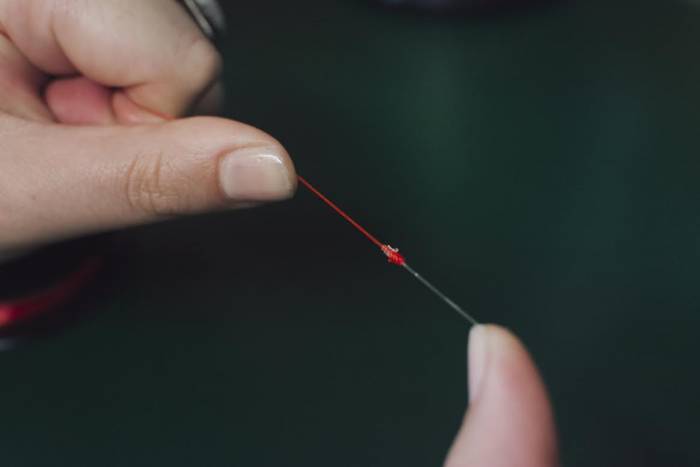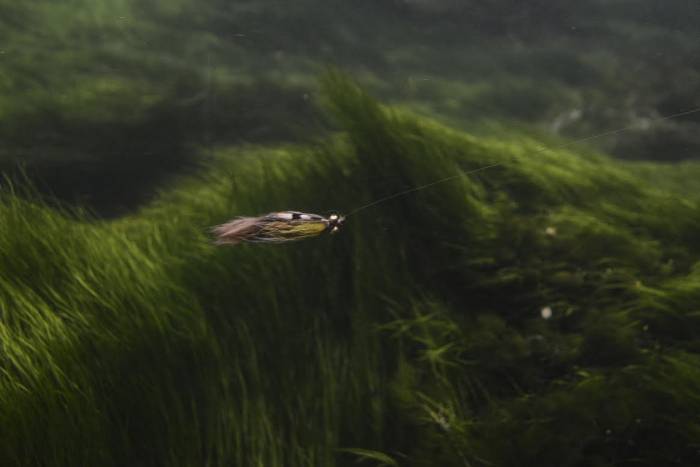The leader and the tippet are crucial elements to fly fishing. Once you’ve got the backing and fly line figured out, you’re ready to learn all about them.
Leaders and tippet, though expendable, are vital pieces of equipment for any fly fisher. Without a solid leader and tippet setup, you run the risk of spooking fish or breaking them off. An appropriate leader means better accuracy, turnover, and presentation. The correct tippet selection ensures it will sink (or float) and be nearly invisible to the fish.
Leaders for Fly Fishing
Tied to your fly line is your leader. The leader starts out thick and strong and tapers toward the end, where the tippet and ultimately your fly are tied.
Leaders can be tapered chemically, mechanically, or by hand by tying pieces of monofilament and tippet material into an effective taper. Chemically and mechanically tapered leaders are smoother and have less to catch on whereas hand-tied leaders turn over and cast into the wind better.
A word on leader and tippet weight: Tippet and leader thickness is denoted by an “X” designation. Weights range from 8X to 0X for most anglers, with the larger number designating a lighter weight line. Lines heavier than 0X are noted by the tippet diameter, such as .012. You should try to balance the weight of your tippet with style of fishing, flies used, and target species. Orvis has a handy chart to do just that here.
Tapered Leaders
Rio makes great chemically tapered leaders, and its Powerflex leader ($12 for a three-pack) is a great all-around option. If you are looking for hand-tied leaders, you can find great taper formulas online, come up with your own, or use George Anderson’s Hand Tied Leaders ($6.95). Most leaders come with a perfection loop to make a loop-to-loop connection from line to leader.
If you do choose a hand-tied leader, you have the advantage of knowing exactly what section of tippet needs to be replaced when the time comes. If you’re fishing a 4X leader and have to frequently retie flies or fish have broken off, you know your last section was 4X and can easily tie more tippet on. A blood knot or surgeon’s knot works best for mono or tippet connections.
Standard leader lengths for trout fishing leaders are usually in the 7.5- to 12-foot range. Fourteen-foot leaders are used by some for dry fly fishing in gin-clear water where you need an extra stealthy presentation. Generally, the longer the leader, the harder it is to cast.
Specialty Leaders
You can also get sinking or indicator leaders. Rio makes the Freshwater VersiLeader ($12.95), which comes in a variety of sink rates. It attaches to a floating line to make it fish like a sinking line. Although this hinges a bit (at the loop-to-loop connection) and adds extra grain weight to your line, it’s a viable option and helps get your fly down.
Indicator leaders like Rio’s Indicator Leader ($14.95 for a three-pack) and George Anderson’s Hot Butt Leader ($6.95) have colored butt sections — orange and red, respectively — which act as indicators. These are great if you don’t want to fish under a strike indicator or have a hard time seeing your line in the water. They’re especially useful when high sticking or “Czech” nymphing.
Tippet for Fly Fishing
Tippet is the final, lightweight line that you tie to your fly. Tippet material varies from fluorocarbon to nylon. In tippets of the same diameter, fluorocarbon is more durable and has greater straight breaking strength than nylon.
Fluorocarbon is also less visible underwater. Water has a refractive index of 1.33, fluorocarbon has a refractive index of 1.42, and nylon comes in at 1.62. In short, if you’re fishing spring creeks, lakes, saltwater, or especially clear rivers, then using fluorocarbon will give you an advantage in fooling (and hooking) more fish.
Fluorocarbon Tippet
Fluorocarbon is usually stiffer, tangles less, and is easier to untangle than nylon. It also doesn’t absorb as much water. So if you’re using the same leader and tippet all day, your tippet won’t become weaker towards the end of the day. Seaguar ($16.50) and Trout Hunter ($24.95) make great fluorocarbon tippets with a double structure.
Double structure means the inner fluorocarbon is stiff and has a high tensile breaking strength and a softer fluorocarbon outer coating. This ties better knots than other brands of fluorocarbon without double structure. The only downside is that fluorocarbon costs nearly three to four times more than nylon.
Nylon Tippet
Nylon is a great all-purpose material. It’s a solid choice wherever water clarity is slightly off. Nylon produces excellent knot strength. It absorbs more water than does fluorocarbon, but for almost all applications, nylon gets the job done well. Rio’s Powerflex ($3.35) is a guide favorite, as is the Powerflex Plus ($11.43). Powerflex Plus is a stronger nylon material, testing 20 percent stronger than the regular Powerflex.
Trout Hunter also just came out with their EVO Nylon Tippet ($9.95). Its coating allows for stronger knots and better floating than traditional nylon.
Nylon floats better than fluorocarbon, making it a good choice when fishing dry flies. But using gink or another silicone gel on your fluorocarbon leader and tippet helps offset this.
Stocking Up on Tippet
When shopping for leaders or tippet, it’s important to keep in mind that it should taper down from the previous section. If you’re buying 6X tippet, you should have some 4X and maybe 2X in your bag as well. Tying 6X directly to 2X would be too much change in diameter to yield sturdy knots and good turnover.
In general, you can use the rule of 3 when deciding what size tippet to use with your fly. If you’re fishing a size 12 fly, divide by 3 and use 4X tippet. If you’re fishing a size 20 fly, divide by 3 and use 6X or even 7X tippet.
Looking Downstream
Don’t forget to be a good steward. Don’t throw your tippet on the ground or in the river. Be especially aware of this if you’re using fluorocarbon, as it has a half-life of approximately 250 years. Leader and tippet scraps create hazards for the environment and wildlife, so try your best to gather your used pieces and dispose of them.
Chloe Nostrant is a photographer and artist from Livingston, Montana. She is an employee at the famed George Anderson’s Yellowstone Angler and executive director of the nonprofit Bridger Babes. She spends her free time chasing her next catch and creating artwork centered around the American West.














